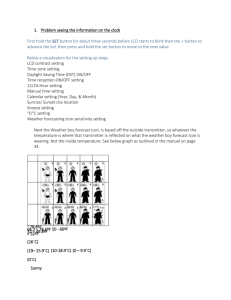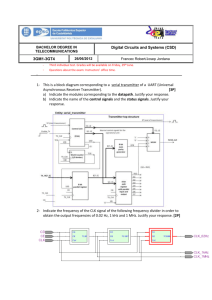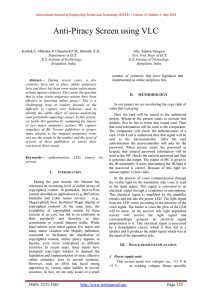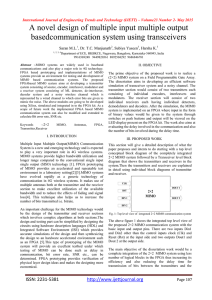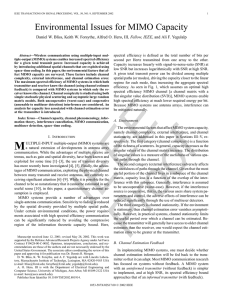Indoor Diffuse Optical MIMO Communication System
advertisement
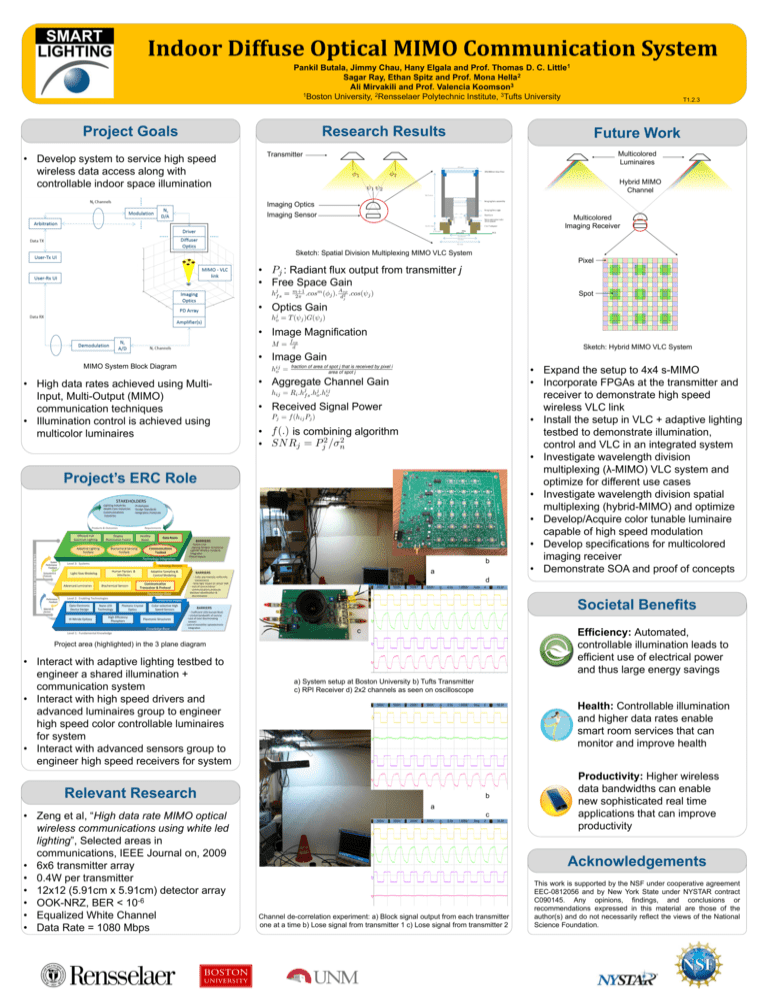
Indoor Diffuse Optical MIMO Communication System Pankil Butala, Jimmy Chau, Hany Elgala and Prof. Thomas D. C. Little1 Sagar Ray, Ethan Spitz and Prof. Mona Hella2 Ali Mirvakili and Prof. Valencia Koomson3 1Boston University, 2Rensselaer Polytechnic Institute, 3Tufts University Project Goals T1.2.3 Research Results Future Work Multicolored Luminaires Transmitter • Develop system to service high speed wireless data access along with controllable indoor space illumination Hybrid MIMO Channel Imaging Optics Imaging Sensor Multicolored Imaging Receiver Sketch: Spatial Division Multiplexing MIMO VLC System Pixel • : Radiant flux output from transmitter j • Free Space Gain Spot • Optics Gain • Image Magnification Sketch: Hybrid MIMO VLC System • Image Gain MIMO System Block Diagram • High data rates achieved using MultiInput, Multi-Output (MIMO) communication techniques • Illumination control is achieved using multicolor luminaires • Aggregate Channel Gain • Received Signal Power • • is combining algorithm Project’s ERC Role STAKEHOLDERS -Lighting Industries -Health Care Industries -Communications Industries -Prototypes -Design Standards -Integration Protocols Products & Outcomes Efficient Full Spectrum Lighting Display Illumination Fusion Adaptive Lighting Testbed SYSTEM REQUIREMENTS Requirements Healthy Room Biochemical Sensing Testbed Data Room Communications Communications Testbed Testbed Technology Integration System Performance Feedback Subsystems & Protocols Level 3: Systems Human Factors & Interfaces Biochemical Sensors Adaptive Sampling & Control Modeling Communication Transceiver & Protocol Technology Base Performance Feedback Materials & Devices Level 2: Enabling Technologies Opto Electronic Device Design III-Nitride Epitaxy b Technology Elements Light Flow Modeling Advanced Luminaires BARRIERS - System Cost - Lighting Designer acceptance - Light/RF Wireless standards integration - Clinical Impacts Nano LED Technology a BARRIERS - Color and intensity uniformity d maintenance - Stray light impact on sensor SNR - Lack of source/sensor communications protocols -Biochem-identification & discrimination Societal Benefits Fundamental Insights Photonic Crystal Optics High Efficiency Phosphors Color-selective High Speed Sensors Plasmonic Structures Knowledge Base BARRIERS - Inefficient LEDs (except Blue) - Limited bandwidth of sources - Lack of color discriminating sensors - Lack of monolithic optoelectronic integration Level 1: Fundamental Knowledge c Efficiency: Automated, controllable illumination leads to efficient use of electrical power and thus large energy savings Project area (highlighted) in the 3 plane diagram • Interact with adaptive lighting testbed to engineer a shared illumination + communication system • Interact with high speed drivers and advanced luminaires group to engineer high speed color controllable luminaires for system • Interact with advanced sensors group to engineer high speed receivers for system a) System setup at Boston University b) Tufts Transmitter c) RPI Receiver d) 2x2 channels as seen on oscilloscope Health: Controllable illumination and higher data rates enable smart room services that can monitor and improve health Relevant Research • Zeng et al, “High data rate MIMO optical wireless communications using white led lighting”, Selected areas in communications, IEEE Journal on, 2009 • 6x6 transmitter array • 0.4W per transmitter • 12x12 (5.91cm x 5.91cm) detector array • OOK-NRZ, BER < 10-6 • Equalized White Channel • Data Rate = 1080 Mbps • Expand the setup to 4x4 s-MIMO • Incorporate FPGAs at the transmitter and receiver to demonstrate high speed wireless VLC link • Install the setup in VLC + adaptive lighting testbed to demonstrate illumination, control and VLC in an integrated system • Investigate wavelength division multiplexing (λ-MIMO) VLC system and optimize for different use cases • Investigate wavelength division spatial multiplexing (hybrid-MIMO) and optimize • Develop/Acquire color tunable luminaire capable of high speed modulation • Develop specifications for multicolored imaging receiver • Demonstrate SOA and proof of concepts b a c Productivity: Higher wireless data bandwidths can enable new sophisticated real time applications that can improve productivity Acknowledgements Channel de-correlation experiment: a) Block signal output from each transmitter one at a time b) Lose signal from transmitter 1 c) Lose signal from transmitter 2 This work is supported by the NSF under cooperative agreement EEC-0812056 and by New York State under NYSTAR contract C090145. Any opinions, findings, and conclusions or recommendations expressed in this material are those of the author(s) and do not necessarily reflect the views of the National Science Foundation.

